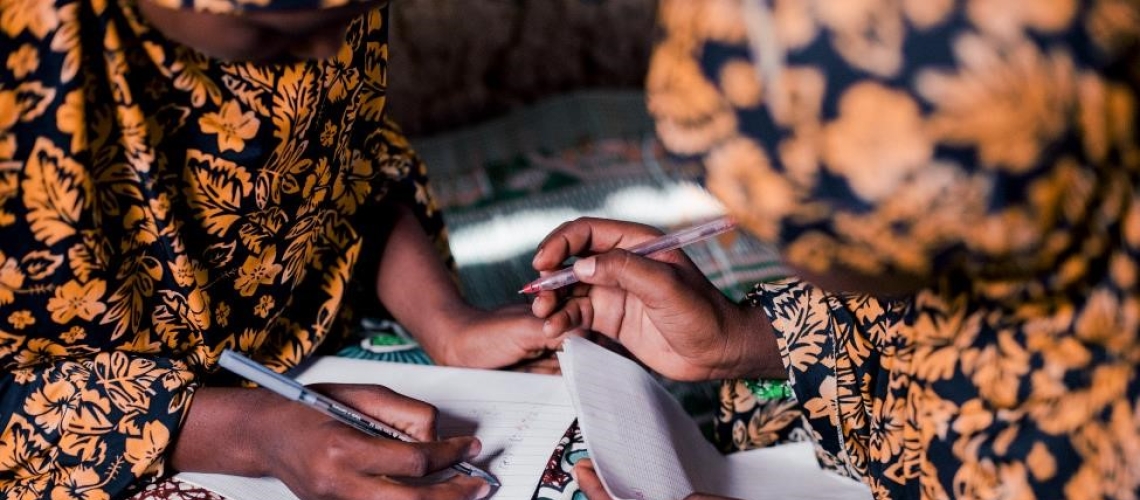Education as a Right for Children in Western and Central Africa

November 20 marks World Children’s Day. The fundamental right of children to an education is reflected in the Universal Declaration of Human Rights and the UN Convention on the Rights of the Child. Unfortunately education is often not a reality for many children living in Western and Central Africa, where almost 80 percent 10-year-olds are learning poor, unable to read and understand a simple text – the highest percentage in the world. High rates of learning poverty indicate that too many children are either not attending school or are in school but not learning.
Our recent blog highlighted the stories of Leah, Hauwa, and Hussaini, three children from the region, whose education has been disrupted primarily due to conflicts. Their stories illustrate challenges millions of children face in accessing and completing education and demonstrate that learning and children’s rights in the region are under pressure.
A renewed hope and vision for children in West and Central Africa
The region has the potential to create equal and inclusive opportunities for all girls and boys arrive at school ready to learn, attain quality learning, and enter the job market with the right set of skills to become productive and fulfilled citizens. This is the vision for the World Bank’s forthcoming Regional Education Strategy for Western and Central Africa (2022-2025).
Though still under preparation, the proposed strategy seeks to promote high-impact interventions and system-wide reforms across the learning lifecycle – from early childhood to tertiary education – building on evidence of what has worked in the region, and globally. It is anchored around three pillars:
- Widening opportunities
- Improving teaching and learning
- Building job-relevant skills
The strategy also calls for strengthening strategic leadership, improving governance and financing of the sector to drive critical reforms, and enhancing implementation capacity for long-term impact.
Equal and inclusive opportunities for all
Although the region has made tremendous gains, provision of universal basic education (primary and secondary education) remains a challenge for many countries. Widespread poverty and school shortages are contributing to low access. In addition, approximately 101 million children were affected by school closures at the peak of the pandemic. We are facing an unprecedented crisis within a crisis.

The region is home to over half of the world’s out-of-school children. Fragility, conflict, and violence (FCV) increase the number of out-of-school children; 11 of the region’s 22 countries are classified as fragile and conflict-affected. In FCV countries, girls are 2.5 times more likely to be out of school than boys, and at the secondary level, are 90% more likely to be out of school than those in non-FCV contexts. (Read more in our recent blog).
To widen children’s opportunities across the region, the World Bank strategy recommends high-impact interventions in five priority areas:
- Reducing the cost of education, especially for the poorest
- Providing information on benefits of education and sources of funding
- Ensuring safe learning environments
- Shifting socio-cultural norms especially for girls
- Increasing the availability, accessibility, and resilience of schools
Arrive at school ready to learn and attain quality learning
Schooling alone won’t solve the problem; high quality learning is critical. Presently, learning levels across the region are abysmally low, reflected by high learning poverty rates. These learning challenges stem from the fact that only 32 percent of children have access to early childhood education, and more than a third of the region’s children under five are stunted. Poor learning outcomes in the region can also be attributed to improper teacher recruitment, poor teacher professional development, and high teacher absenteeism. Teachers are critical determinants of student learning and all children deserve great teachers; yet, a survey of six Sub-Saharan Africa countries unveiled that many children do not have access to high-quality teachers. Subpar school environments where students are taught in a language they do not understand, and where basic teaching material and adequate infrastructure are lacking, also worsen the already poor learning outcomes.
To address the learning crisis in the region, the strategy prioritizes the following areas:
- Enhancing students’ readiness to learn
- Investing in teacher competency and skills
- Fostering a culture of learning assessments
- Providing learning resources and EdTech tools
- Fostering conducive learning environments
- Strengthening managerial capacity
Enter the job market with the right set of skills to become productive and fulfilled citizens
Protecting children’s right to education goes beyond primary and secondary education. Gross enrollment in higher education is low, at approximately 10% in the region. Tertiary education institutions often do not provide graduates with job-relevant, digital, and technological skills that are critical to transition from labor-intensive jobs, to jobs of the 21st century. The strategy will also focus on addressing the skills and workforce development challenges in the region: (i) strengthening governance of education providers; (ii) removing barriers to skills acquisition; (iii) managing service delivery for quality and relevance; and (iv) fostering sustainability of service delivery. Specific interventions are detailed in the recent blog titled “Youth empowerment: Reimagining and transforming skills development in Western and Central Africa.”
Advocating for the responsibility of protecting children’s right to education
We need to draw attention to learning outcomes in the region. The priorities outlined above, highlight where key stakeholders – policy makers, development partners, civil society, private sector, the media, and so forth – can work collectively and collaboratively to provide quality education for children like Leah, Hauwa, Hussaini, and all children in West and Central Africa. In doing so, we will fulfill the ambitious, but achievable vision of the regional education strategy and contribute towards achieving Sustainable Development Goal (SDG) 4, the Continental Education Strategy for Africa 2016-2025 (CESA 16-25), and Africa’s Agenda 2063.
Before the strategy is finalized, we welcome your thoughts on the above-referenced framework, and the high-impact interventions. Please include a comment below with your brief advice for the team.
